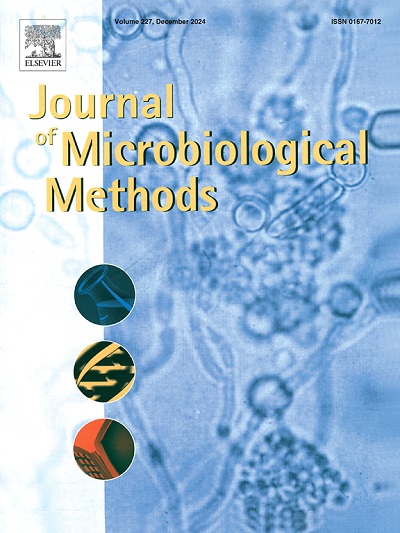A rapid, reliable, and cost-effective method for monitoring Mycoplasma spp. growth in real-time using Resazurin fluorescence
IF 1.9
4区 生物学
Q4 BIOCHEMICAL RESEARCH METHODS
引用次数: 0
Abstract
Mycoplasmas are small, slow-growing bacteria that do not produce visible turbidity in broth. Monitoring the growth of these fastidious organisms requires the manual sampling of cultures over several days, followed by cumbersome enumeration methods with long incubation periods or complex assays unable to differentiate live and dead cells. Here, a simple, automated assay was developed to measure Mycoplasma growth by quantifying the reduction of resazurin, a non-toxic dye, into a fluorescent product by live organisms. Mycoplasma species were cultivated in broth containing 2.5 mg/L resazurin. Fluorescence (520 nm excitation, 555 nm emission) was recorded every 5 min for 24 h using a qPCR thermocycler set at 37 °C, to capture the logarithmic and plateau phases. Growth curves and generation times obtained from fluorescence readings were highly similar to those calculated from the Most Probable Number (MPN) titres analysis of broth cultures sampled every 2 h over the same timeframe. Additionally, the resazurin assay could rapidly differentiate temperature-sensitive mutants from wild-type strains, by comparing their maximal growth rates in permissive (33 °C) and non-permissive (39 °C) conditions. While the MPN titration protocol required tedious liquid handling and weeks-long incubation to produce interpretable data, the resazurin assay delivered results in less than 24 h. Unlike the MPN method, which relies on pH changes, the resazurin assay could be used with non-acidifying Mycoplasmas. In conclusion, resazurin-based fluorescence monitoring provides a practical and accurate solution to quantify Mycoplasma growth, with strong potential for diagnostic and research applications.
一种快速、可靠、具有成本效益的利用瑞唑脲荧光实时监测支原体生长的方法
支原体是一种生长缓慢的小细菌,在肉汤中不会产生明显的浑浊。监测这些挑剔的生物的生长需要在几天内对培养物进行人工采样,然后是冗长的计数方法,潜伏期长,或者是无法区分活细胞和死细胞的复杂测定。在这里,开发了一种简单的自动化检测方法,通过量化活生物体将无毒染料reazurin还原为荧光产物来测量支原体的生长。支原体在含2.5 mg/L瑞祖林的培养液中培养。荧光(520 nm激发,555nm发射)用qPCR热循环仪在37°C下每5分钟记录一次,持续24 h,以捕获对数和平台相。从荧光读数获得的生长曲线和产生次数与在同一时间段内每2小时取样的肉汤培养物的最可能数(MPN)滴度分析计算的结果高度相似。此外,通过比较温度敏感突变体在允许(33°C)和非允许(39°C)条件下的最大生长速率,resazurin试验可以快速区分温度敏感突变体与野生型菌株。虽然MPN滴定方案需要繁琐的液体处理和长达数周的孵育才能产生可解释的数据,但resazurin测定在不到24小时内就能得出结果。与MPN方法不同,该方法依赖于pH变化,resazurin测定可以用于非酸化支原体。总之,基于瑞沙脲的荧光监测为支原体生长提供了一种实用、准确的定量解决方案,具有很强的诊断和研究应用潜力。
本文章由计算机程序翻译,如有差异,请以英文原文为准。
求助全文
约1分钟内获得全文
求助全文
来源期刊

Journal of microbiological methods
生物-生化研究方法
CiteScore
4.30
自引率
4.50%
发文量
151
审稿时长
29 days
期刊介绍:
The Journal of Microbiological Methods publishes scholarly and original articles, notes and review articles. These articles must include novel and/or state-of-the-art methods, or significant improvements to existing methods. Novel and innovative applications of current methods that are validated and useful will also be published. JMM strives for scholarship, innovation and excellence. This demands scientific rigour, the best available methods and technologies, correctly replicated experiments/tests, the inclusion of proper controls, calibrations, and the correct statistical analysis. The presentation of the data must support the interpretation of the method/approach.
All aspects of microbiology are covered, except virology. These include agricultural microbiology, applied and environmental microbiology, bioassays, bioinformatics, biotechnology, biochemical microbiology, clinical microbiology, diagnostics, food monitoring and quality control microbiology, microbial genetics and genomics, geomicrobiology, microbiome methods regardless of habitat, high through-put sequencing methods and analysis, microbial pathogenesis and host responses, metabolomics, metagenomics, metaproteomics, microbial ecology and diversity, microbial physiology, microbial ultra-structure, microscopic and imaging methods, molecular microbiology, mycology, novel mathematical microbiology and modelling, parasitology, plant-microbe interactions, protein markers/profiles, proteomics, pyrosequencing, public health microbiology, radioisotopes applied to microbiology, robotics applied to microbiological methods,rumen microbiology, microbiological methods for space missions and extreme environments, sampling methods and samplers, soil and sediment microbiology, transcriptomics, veterinary microbiology, sero-diagnostics and typing/identification.
 求助内容:
求助内容: 应助结果提醒方式:
应助结果提醒方式:


